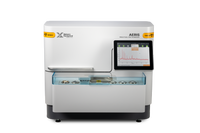Crystallographic analysis of X-ray diffraction data
The ancient Greeks believed that Krystallos (crystal) was light frozen into ice and that it was so hard that it could never be melted. In later times, crystallography started as a science which studied the outer symmetry of crystals in order to try to explain the inner side of crystals. Father and son Bragg were the first ones that used X-ray diffraction (XRD) to study the inside of crystals and showed the periodic arrangement of atoms in a crystal.
Nowadays X-ray crystallography is used in many fields of chemistry, mineralogy and physics. Not only in the so-called crystalline state (ordered position of ions, atoms or molecules) but also in the amorphous and liquid states that do not have long-order periodicity.
Crystallography is the basic science underlying the determination of new structures, phase quantification using e.g. Rietveld method total scattering, texture analysis etc.
The needed steps for the crystallographic analysis of powder XRD data are all included in the HighScore Plus software:
Crystallographic analysis needs the highest quality diffraction data. Malvern Panalytical’s Empyrean Alpha-1 configured with a Ge monochromator (Johansson type) gives perfect Cu or Co Kα1-only Bragg-Brentano reflection geometry data for structure determination. Using a PreFIX hybrid monochromator, an α1-only parallel beam transmission geometry is created on Empyrean for transmission or capillary work.

Empyrean rangeMultipurpose X-ray diffractometers for your analytical needs |

AerisThe future is compact |
|
|---|---|---|
| Technology | ||
| X-ray Diffraction (XRD) | ||